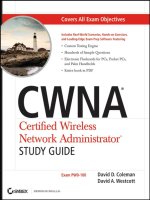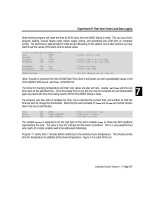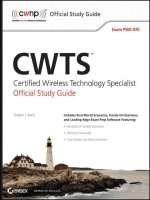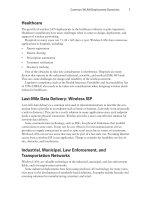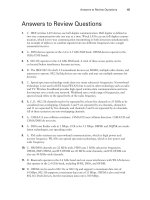cwts certified wireless technology specialist official study guide exam pw0 070 phần 8 pps
Bạn đang xem bản rút gọn của tài liệu. Xem và tải ngay bản đầy đủ của tài liệu tại đây (1.44 MB, 50 trang )
Performing a Predictive Site Survey
307
Client Device Such as a Notebook Computer A device to take measurements from the
client side is an important component of the site survey kit. This can be a notebook com-
puter or Pocket PC with appropriate software to take signal measurements. Size and weight
should be considered as well. A Wi-Fi, VoIP handset may also be used for locations that are
considering WLAN Voice over Internet Protocol capabilities.
Battery Packs or Extension Cords Battery packs to temporarily power access points are
recommended. However, if these are not available, extension cords are a good substitute.
The disadvantage of extension cords is that they require accessible AC power outlets,
which might not be available at all sites. An extra battery pack for the survey device is also
recommended.
Various Antennas (If Required) If antennas other than those mounted directly to an
access point will be used in the deployment, a variety of these antennas should be on hand
for testing during the site survey process. If 802.11n technology will be tested during the
site survey, appropriate 802.11n antennas will be required as part of the site survey kit.
Temporary Mounting Hardware Mounting hardware for temporarily mounting access
points and antennas should also be considered, including expandable poles, brackets, tape,
and nylon tie straps.
Measuring Device, Either Tape or Wheel A measuring tape or wheel is recommended
for measuring distance to wiring closets and distance between access points and any other
areas where distance is of importance.
Digital Camera As they say, a picture is worth a thousand words. Using a digital camera
to take photographs of situations that may be difficult to explain in writing is a great help.
This also adds quality to site survey reports.
Pens, Pencils, and Paper Documentation is a critical part of wireless site surveys as well as
all other areas of the network. Keeping clean and accurate notes will allow the surveyor to
document areas of importance.
Ladder Ladders or lifts are required for mounting temporary access points and antennas.
The height of the ladder or lift will depend on the mounting locations for the access points.
Cart A cart or dolly to move all equipment used for the site survey will ease the burden of
getting the equipment around the facility.
Performing a Predictive Site Survey
A predictive site survey can be an accurate way to design a wireless LAN without having
to spend time on-site performing a physical walkthrough and testing of the entire loca-
tion. This type of site survey can be performed a couple of different ways depending on the
equipment used. You can use a commercial software program designed specifically for this
purpose or, in some cases, manufacturers build this site survey functionality directly into a
wireless LAN controller/switch.
38893c09.indd 307 5/19/09 6:17:27 AM
308
Chapter 9
N
Performing a WLAN Site Survey
This type of site survey requires the wireless engineer or surveyor to input a floor plan
drawing of the facility, such as a CAD, JPEG, BMP, or other format file, directly into the
software program or the controller/switch. Then information and details such as the atten-
uation values of the facility is added. This information includes:
Type of walls: for example, drywall, brick, or poured concrete
ÛN
Thickness of walls
ÛN
Types of windows, including glass, thickness, and coating
ÛN
Type of doors, such as hollow core, solid core, fire doors, wood, steel
ÛN
Location of certain types of furnishings, such as cubicle offices
ÛN
Height of ceiling
ÛN
One thing to keep in mind about a predictive site survey is that the accuracy and final
results are only as good as the information that was input into the program. It is essential
for the surveyor to use accurate information about the location, including the attenuation
value of all the building materials. Figure 9.13 shows a predictive analysis site survey tool.
FIGURE 9.13 Motorola LANPlanner showing a predictive modeling site survey
Listed are some the advantages and disadvantages of using the predictive site survey
process:
Advantages
ÛN
Limited time on-site
ÛN
Does not require a complete physical walkthrough for testing
ÛN
38893c09.indd 308 5/19/09 6:17:28 AM
Performing a Predictive Site Survey
309
Allows for easy adjustment of access point locations and settings
ÛN
Can model different scenarios
ÛN
Disadvantages
ÛN
Surveyor may be unfamiliar with the location’s physical characteristics
ÛN
Accuracy limited to data input within program
ÛN
Requires extensive knowledge of physical properties of the installation area includ-
ÛN
ing attenuation values
In Exercise 9.3, you will explore a predictive site survey program.
EXERCISE 9.3
Predictive Site Survey Demonstration
In this exercise, you will install the Motorola LANPlanner program. This site survey demo
program can be requested by contacting the Motorola Enterprise Mobility Group at
www
.motorola.com
.
1. Start the installation by executing the LANPlanner setup program.
2. The LANPlanner Setup dialog box will appear. Click Next to start the installation wizard.
3. The License Agreement dialog box will appear. Read the license agreement; if you
agree, select the “I accept” radio button and click Next. The serial number dialog box
will appear. Fill in the blank fields, then click Next.
4. The Destination Folder dialog box will appear. Accept the default location by
clicking Next.
5. The Start Installation dialog box will appear. Click Next to start the installation.
6. The LANPlanner Program Has Been Successfully Installed dialog box will appear.
Click Finish to complete the installation.
38893c09.indd 309 5/19/09 6:17:28 AM
310
Chapter 9
N
Performing a WLAN Site Survey
7. Click on the LANPlanner icon on your desktop. The LANPlanner program will start
and the Activation Code Not Found dialog box will appear on the screen. Click OK to
start the evaluation process.
8. The License Maintenance dialog box will appear. Click Exit Update Dialog to continue
the evaluation. This product can be evaluated for two days.
9. Click the File dropdown box and New/Open Project. The Building Wizard Setup dia-
log box will appear; click Next. Click No in the Save Changes dialog box.
10. The default sample drawing will appear on the screen. You can resize the drawing by
left-clicking and dragging on the magnifying glass icon. Place an access point on the
drawing by selecting the Equipment dropdown box and Place Access Point.
EXERCISE 9.3 (continued)
38893c09.indd 310 5/19/09 6:17:28 AM
Performing a Predictive Site Survey
311
11. Select an access point from the list with your mouse. Double-click on the desired
access point and drag it to an area on the floor plan. Click your left mouse button to
place the access point.
12. Hit the ESC button on your keyboard and click Exit in the Place Access Point
dialog box.
13. Click on the Network Design dropdown box and Quick Predict. The quick Predict
dialog box will appear; click Next to continue.
14. The Select Access Point dialog box will appear. Select an access point and click OK.
15. Move your mouse around throughout the floor plan to see the predicted signal read-
ings based on the characteristics of the building.
16. Press the ESC button on your keyboard to return to the floor plan screen. Click on
various buttons and menus to explore the features associated with this program.
When finished with the demonstration, exit the program by clicking on the File drop
down menu and Exit. Click No in the Save Changes dialog box.
After you have completed the exercise and evaluation process, you can remove the soft-
ware from your computer.
EXERCISE 9.3 (continued)
38893c09.indd 311 5/19/09 6:17:28 AM
312
Chapter 9
N
Performing a WLAN Site Survey
There are many different site survey programs to choose from, both commercial and
freeware or shareware. You should compare the programs and determine which would be
best suited for your environment based on features, cost, and capabilities. Listed are many
common programs for predictive modeling or manual site surveys that are available on the
market today.
Site Survey Program Web site
AirMagnet Survey/Planner
www.airmagnet.com
Airtight Networks www.airtightnetworks.com
Berkeley Varitronics Systems
(BV Systems) Swarm
www.bvsystems.com
Ekahau Site Survey www.ekahau.com
Fluke Networks InterpretAir www.flukenetworks.com
Helium Networks Wireless Recon www.heliumnetworks.com
Motorola LANPlanner www.motorola.com
Motorola SiteScanner www.motorola.com
Psiber RF3D WiFiPlanner www.psiber.com
VisiWave – AZO Technologies www.visiwave.com
InSSIDer (freeware) www.metageek.net
NetStumbler (donationware) www.netstumbler.com
Some wireless client adapter utilities can also be used in site surveys.
Protocol Analysis
Wireless LAN protocol analyzers are becoming a common tool, and many network admin-
istrators will have one as part of their wireless LAN toolkit. A protocol analyzer will allow
a network administrator or engineer to view all wireless frames that are traversing across
the air in the hearing range of the analysis device. At one time protocol analysis was a spe-
cialty role, and without extensive training few people had the skills to perform this task.
Along with the evolution of wireless LAN technology in recent years, protocol analyzers
38893c09.indd 312 5/19/09 6:17:28 AM
Protocol Analysis
313
are becoming more mainstream, affordable, and easier to use. Many variations of analyzers
are available in the market today. Listed are some of the manufacturers and their products:
Manufacturer Product Web Site
AirMagnet WiFi Analyzer
www.airmagnet.com
BV Systems Yellowjacket www.bvsystems.com
Motorola AirDefense Mobile www.airdefense.net
NetScout Sniffer www.netscout.com
Network Instruments Observer www.networkinstruments.com
TamoSoft CommView for WiFi www.tamos.com
WildPackets OmniPeek www.wildpackets.com
Most wireless protocol analyzers require the use of certain network adapters
and in many cases use a special device driver. It is recommended to verify
you have access to an adapter that is supported by the protocol analyzer’s
manufacturer.
Protocol analyzers are available in software programs that can be installed on a notebook
computer or Pocket PC and are also available in specialty dedicated handheld devices. In
addition to performing protocol analysis or frame decoding, many analyzers are feature rich
with the capability to view security information, perform legislative compliance analysis and
reporting, and generate a variety of different reports. Figure 9.14 shows an example of a wire-
less LAN protocol analyzer.
The main goals of a wireless LAN analyzer or any protocol analyzer are to troubleshoot
network problems, gather information about security issues, and optimize the network’s
performance. When it comes to wireless LAN site surveys, a protocol analyzer is a valuable
tool for evaluating which wireless LAN devices are currently in the same RF space where the
proposed wireless LAN will be deployed. They can also be used to view the signal strength,
security implementations, the network name or SSID, and which channels access points and
other devices are currently operating on. An analyzer will show not only access points but
any wireless LAN device that may have an impact on the site survey and deployment. Some
of the devices an analyzer is able to locate and identify include:
Access points
ÛN
Ad hoc networks
ÛN
Wireless bridges
ÛN
Mesh networks
ÛN
Client devices
ÛN
38893c09.indd 313 5/19/09 6:17:29 AM
314
Chapter 9
N
Performing a WLAN Site Survey
FIGURE 9.14 OmniPeek by WildPackets identifies nearby wireless networks
In Exercise 9.4, you will explore a protocol analyzer.
EXERCISE 9.4
Protocol Analyzer Demonstration
In this exercise you will install the CommView for WiFi protocol analyzer by TamoSoft.
This protocol analyzer demo program is included on the CD that comes with this book.
1. Locate the CommView for WiFi setup program located on the CD that is included with
this book.
2. Start the setup process by executing the setup.exe program
3. The CommView for WiFi setup wizard will appear on the screen. Click Next to start
the installation process.
4. The license agreement will appear. Read the license agreement; click Yes. The Select
Installation Folder dialog box will appear.
5. A second license agreement will appear applicable to Intel adapters only. If this per-
tains to you, read the agreement and click Yes to agree. If this does not pertain to
you, click N/A.
6. The License Type dialog box will appear. For this demonstration, select the radio but-
ton next to Standard Mode and click Next.
38893c09.indd 314 5/19/09 6:17:29 AM
Protocol Analysis
315
7.
The Destination Location dialog box will appear. Click Next to accept the default location.
8. The Select Program Manager Group dialog box will appear. Select Next to accept the
default Program Manager Group.
9. The Additional Settings Dialog box will appear. Select the appropriate language and
deselect the checkbox next to “Launch CommView for WiFi once the installation has
been completed.”
10. The Start Installation dialog box will appear. Click Next to start the installation.
11. After the installation is complete, the CommView for WiFi dialog box will appear.
Click Finish to complete the installation.
12. Click on the CommView for WiFi icon on your desktop to start the program.
EXERCISE 9.4 (continued)
38893c09.indd 315 5/19/09 6:17:29 AM
316
Chapter 9
N
Performing a WLAN Site Survey
13. The program will attempt to start and the Driver Installation Guide dialog box will
appear. Read this guide and verify you have a supported wireless adapter.
14. At the bottom of the Driver Installation Guide dialog box, click Next to start the instal-
lation wizard.
15. The Driver Installation dialog box will appear. Select the appropriate radio button and
click Next.
16. A second Driver Installation dialog box will appear. Select the “I want the program to
install the driver automatically” radio button and click Next.
17. A third Driver Installation dialog box will appear. Select the supported adapter from
the list and click Install Driver.
EXERCISE 9.4 (continued)
38893c09.indd 316 5/19/09 6:17:30 AM
Protocol Analysis
317
18. Click the Restart Windows Now button in the Driver Installation dialog box. The
device driver has been updated and your computer will restart.
19. After your computer restarts, log in and start the CommView for WiFi program by
double-clicking on the icon on your desktop. The evaluation version of the program
will start.
20. Click on the arrow in the upper left corner of the program window or click on the File
dropdown box and Start Capture to start a capture with the program. The Scanner
dialog box will appear.
21. Select the channel you wish to view or click on the Start Scanning button. Then click
Capture.
22. The screen will show all devices captured on the channel scanning.
22. Click on various buttons to see the features associated with this program. When
finished with the demonstration, exit the program by clicking on the File dropdown
menu and Exit.
23. A “Thank you for trying this evaluation version” dialog box will appear. Click OK to
close the program.
24. Using Device Manager, restore the original device driver for the wireless network
adapter used with this demonstration.
After you have completed the exercise and evaluation process, you can remove the soft-
ware from your computer.
EXERCISE 9.4 (continued)
38893c09.indd 317 5/19/09 6:17:30 AM
318
Chapter 9
N
Performing a WLAN Site Survey
Surveying Networks with a Mesh Access Layer
As discussed in Chapter 2, “Wireless LAN Infrastructure Devices,” mesh technology
is becoming more prevalent in the wireless LAN industry. This technology was origi-
nally popular for outdoor implementations but is becoming more common indoors as
well. Newer mesh access points or routers typically are dual-band, supporting both the
2.4 GHz ISM and 5 GHz UNII bands. In many cases, different RF bands will be used for dif-
ferent functions. The 2.4 GHz ISM band is popular for client access. This is because many
client devices only support the 2.4 GHz ISM band. The 5 GHz UNII band is sometimes used
for infrastructure device connectivity only. This will limit contention with client devices
accessing the network. The number of client devices that currently utilize the 5 GHz UNII
band is still limited. Therefore the amount of potential interference is less than with the
2.4 GHz band.
When performing a site survey, either indoors or outdoors, in which mesh technology will
be used, it is important to survey for both RF bands. Keep in mind that the propagation char-
acteristics of the two frequencies will be different as well as the amount of interference.
Documenting Existing
Network Characteristics
Existing wireless networks can play a big role in a new wireless LAN deployment. Under-
standing the current location of infrastructure and other wireless LAN devices is an important
part of a site survey. One way to see devices that are part of a wireless network is to use a pro-
tocol analyzer. Other programs will also be able to view existing wireless networks, such as
NetStumbler and InSSIDer, and in some cases these programs may be adequate based on the
complexity and size of the site survey. But these typically do not have the extensive feature set
that many protocol analyzer packages have.
Some of the questions that need to be taken into consideration when performing a wire-
less LAN site survey are:
What frequency range will the new wireless LAN operate in?
ÛN
Are there any existing wireless LANs in the same RF space?
ÛN
Will all or part of the existing wireless LAN be utilized in the new deployment?
ÛN
What effect will the neighboring wireless networks have on this deployment?
ÛN
Ignoring existing wireless networks may have a significant impact on how the wireless
LAN will operate and result in poor performance for the clients or devices that will be
connecting.
Figure 9.15 shows an example of a software tool that will identify existing wireless
networks.
38893c09.indd 318 5/19/09 6:17:30 AM
RF Coverage Requirements
319
FIGURE 9.15 InSSIDer by MetaGeek can identify wireless networks
RF Coverage Requirements
As mentioned previously, one of the main goals of a wireless LAN site survey is to determine
areas of RF interference and RF coverage. The details of the required coverage and capacity
in any wireless network are part of the wireless LAN design, which involves determining the
need, use, and business requirements of the network. This was discussed in Chapter 8. Some
of the factors that need to be taken into consideration during a physical site survey are:
Size of area
ÛN
Number of users
ÛN
Obstacles
ÛN
Signal propagation
ÛN
Radio frequency range
ÛN
Bandwidth requirements of applications to be used
ÛN
Frequency of WLAN hardware
ÛN
The planning process will provide some of the answers while a visit and on-site testing
will determine others, such as obstacles, signal propagation, and RF range.
38893c09.indd 319 5/19/09 6:17:30 AM
320
Chapter 9
N
Performing a WLAN Site Survey
Infrastructure Hardware
Selection and Placement
In addition to identifying areas of RF coverage and interference, a site survey will also deter-
mine the best locations for wireless access points and other infrastructure devices. The correct
placement of these devices is important in order to allow clients and devices to benefit fully
from the deployment of wireless LAN. The location of these devices is traditionally partly
based on the following criteria:
RF coverage
ÛN
Bandwidth
ÛN
Aesthetics
ÛN
Applications
ÛN
Cell overlap
ÛN
Channel reuse
ÛN
Mapping out the infrastructure device placement is considered part of the planning pro-
cess. Manual, software assisted, or predictive site survey processes will help identify the
proper locations based on the items mentioned above. In most cases, a preliminary visit to
the location is highly recommended regardless of the site survey method that will be used.
Knowing the physical location will benefit the entire site survey process because it will help
identify areas of concern.
Infrastructure Connectivity and Power
Requirements
Even though the main objectives of this book are all about wireless networking, it is still
important to understand that infrastructure devices require some sort of wired connectivity
for data and electrical power. Data access will usually come by way of an Ethernet connection
from a wired network infrastructure or backbone. As stated in the IEEE 802.3 Ethernet
standard, the maximum length for unshielded twisted-pair Ethernet cable is 328 feet or
100 meters. This limitation may have an impact on how and where access points and other
infrastructure devices are placed.
During the site survey process, the surveyor will likely need access to wiring closets.
Another consideration is power requirements. Infrastructure devices need electrical
power as well as data connectivity to operate. If the electrical power is decentralized and
located at each device, an electrician will need to evaluate and determine the requirements.
38893c09.indd 320 5/19/09 6:17:30 AM
Received Signal Strength
321
Another option for supplying electrical power to infrastructure devices is Power over
Ethernet (PoE). This technology is now very common and is supported by all enterprise
device manufacturers. A survey of the wired infrastructure and devices is almost always
required to determine if the infrastructure will be capable of handling the new PoE devices
that will be installed. Keep in mind that zoning and building regulations, electrical contrac-
tors, and union requirements may add to the overall cost of WLAN deployment. PoE was
discussed in Chapter 2, “Wireless LAN Infrastructure Devices.”
Received Signal Strength
The main objective of a wireless network is to provide access to resources and services for
devices that are connected to the network. This means it is essential for client devices to
have reliable connectivity to the wireless network infrastructure. In order to provide this
connectivity, the site survey process should include testing to verify that the received signal
is adequate for the application of the device.
Devices that communicate wirelessly require two-way communications in order to oper-
ate correctly. This means the receiver must be able to receive enough of the signal in order
to determine the data that was sent from the transmitter. Wireless LAN devices use what is
known as the received signal strength to show the amount of power received from a transmis-
sion. Figure 9.16 shows a client utility that displays specifics regarding the received signal.
FIGURE 9.16 Broadcom wireless utility shows signal, noise, and data rate
38893c09.indd 321 5/19/09 6:17:30 AM
322
Chapter 9
N
Performing a WLAN Site Survey
The amount of received signal strength required will be determined by the type or appli-
cation of the device as well as the amount of RF noise in the area. RF noise is extraneous
undesired radio signals in the area emitted by a variety of devices other than the transmitter. You
should check with the device manufacturer to determine the minimum amount of received
signal that is acceptable for a specific application. Some applications will require more received
signal than others. For example, the manufacturer of a voice handset may recommend a mini-
mum of –65 dBm whereas a computer network card may require a minimum of –70 dBm.
The signal-to-noise ratio (SNR) is the difference between the received signal and the
noise floor. For example, if the received signal is –65 dBm and the noise floor is –95 dBm,
then the signal-to-noise ratio will be 30 dB. This value is calculated by subtracting the
received signal from the noise. In this case –65 dBm – (–95 dBm) = 30 dB.
The recommended signal-to-noise ratio (SNR) for most wireless LAN sys-
tems is a minimum of 20 to 25 dB.
Table 9.1 shows received signal minimums for specific data rates. These values will vary
by manufacturer.
TABLE 9.1 Examples of Minimum Received Signal Strengths Required for Specific
Data Rates
Data Rate (mbps) 2.4 GHz (dBm) 2.4 GHz (dBm) Voice 5 GHz (dBm)
54 –61 –56 –58
36 –63 –58 –63
24 –67 –62 –67
12/11 –72 –67 –72
6/5.5 –79 –74 –75
2 –81 –76 N/A
1 –84 –79 N/A
Source: Certified Wireless Network Administrator (CWNA)
In IEEE 802.11 wireless LAN technology, the received signal strength indi-
cator (RSSI) value is an arbitrary number assigned by the device manu-
facturer. There is no standard for this value and it will not be comparable
between devices from different manufacturers. When performing a site
survey, whenever possible it is beneficial to survey with the same network
adapter model that will be used in the deployment. This will provide more
accurate results for the client devices using the network.
38893c09.indd 322 5/19/09 6:17:30 AM
Antenna Use Considerations
323
Antenna Use Considerations
In Chapter 6, “WLAN Antennas and Accessories,” we looked at various types of antennas,
including omnidirectional, semidirectional, and highly directional models. The characteris-
tics and features of these antennas were discussed as well as the best use for each based on
a specific scenario. As part of a site survey, it may be necessary to test different antennas to
determine the best RF coverage. This usually involves the surveyor connecting and tempo-
rarily mounting various types of antennas to access points in order to determine the proper
radiation pattern and to verify RF coverage within the desired area. A temporary antenna
mounting example is shown in Figure 9.17.
FIGURE 9.17 Expandable light pole used for temporary mounting and testing of a
Yagi and Patch antennas
Testing Multiple Antenna Types
If different antennas will be used in the deployment, it is important for the surveyor to
have several different types of antennas as part of the site survey kit. Some organizations
that deploy wireless networks are extremely concerned about aesthetics, therefore they will
38893c09.indd 323 5/19/09 6:17:32 AM
324
Chapter 9
N
Performing a WLAN Site Survey
allow only specific types of antennas to be used. For example, if access points with remov-
able antennas are used, in many cases the only type allowed will be omnidirectional anten-
nas that are attached directly to the access point with a gain of about 2 or 3 dBi. Other
deployments may use lightweight access points in which antennas are permanently part of
the access point and cannot be removed or changed.
Keep in mind that polarization of antennas must be taken into consideration
during a manual site survey. Polarization of antennas for infrastructure
devices is critical and tests should mimic as closely as possible what will
actually be installed. With the variety of client devices that may be used
in a wireless network, it is a challenge to predict the polarization of all the
devices that might be used. However, it is advisable for the surveyor to take
this into consideration during the site survey.
Choosing the Correct Antennas
Choosing the correct antenna to be used in a specific deployment is part of the wireless
design and site survey process. Many factors play a role in determining which antenna
will be best for the application. Some locations have strict requirements about the type of
antenna that may be used. Therefore the surveyor may have to work with specific antennas
to ensure proper RF coverage. The following factors should to be taken into consideration
when choosing antennas.
Manufacturer’s recommendations The manufacturer of an access point may recommend
only a specific type of antenna. If this is the case, it is important to perform the site survey
with the same type of antenna.
Customer requirements A customer may require only specific types of antennas to be
used. In this case, the survey should be performed with the type of antenna required by
the customer. For example, a deployment consisting of walled offices may require the use
of thin access points. Usually this type of access point uses an omnidirectional internal
antenna.
Environmental conditions The environment where the wireless network is installed may also
determine the type of antenna to be used. If the location is a factory with harsh environmental
conditions, that could have an impact on the type of antenna and may also call for an enclo-
sure for the access point.
Aesthetics Many organizations are sensitive to the type of devices that are visibly seen
by customers and clients. Therefore aesthetically pleasing antennas may be required by the
customer in order to be a good fit for the location in which they will be used. Figure 9.18
shows an example of this type of antenna.
38893c09.indd 324 5/19/09 6:17:32 AM
Channel Architectures
325
FIGURE 9.18 Ceiling mount antenna from L-com
Im age provIded by ww w.L-com.com.
Required coverage The required RF coverage will also affect the choice of antenna as well
as the gain of the antenna. For example, a large office area may require the use of omnidi-
rectional antennas that are physically attached to access points. A manufacturing facility
may require semidirectional antennas to cover areas of the manufacturing floor.
Number of access points The number of access points to be installed in a location will also
be a determining factor in the type of antenna to be used. An office building with a combina-
tion of walled offices and cubicles may have a dense deployment of access points with a limited
number of users connecting to any particular access point. Omnidirectional antennas con-
nected directly to the access point may be an adequate solution for this type of deployment.
Physical geometry of location The attributes of the physical location will have an affect on
the type of antenna to be installed and therefore should be tested during the site survey. This
includes propagation of the signal and attenuation of obstacles. In the case where a building
has long hallways or corridors, a Yagi antenna would be a good candidate for a solution.
Channel Architectures
There are two common types of channel architectures available today that pertain to wire-
less LAN technology. In wireless LAN technology, channel architecture is the design,
layout, or channel plan in use. In the 2.4 GHz band, for example, using channels 1, 6, and
11 non-overlapping channels is a channel architecture. The CWNP program defines these
two architectures and coined the terms known as multiple channel architecture (MCA) and
single channel architecture (SCA).
38893c09.indd 325 5/19/09 6:17:33 AM
326
Chapter 9
N
Performing a WLAN Site Survey
Multiple Channel Architecture (MCA)
Most wireless LAN deployments today use multiple channel architecture (MCA). This type
of installation will use access points set to different RF channels in order to avoid overlap-
ping channel interference, as shown in Figure 9.19. A channel plan may be used with access
points set to specific channels, or in many cases automatic channel selection allows the
devices to choose the best channel to operate on. Until recently this is how all wireless LAN
access points were deployed.
Single Channel Architecture (SCA)
Single channel architecture (SCA) is a fairly new wireless networking technology. SCA
allows all access points to communicate on the same RF channel. The controller that the
access points are connected to manages these access points and avoids co-channel interfer-
ence. In single channel deployments, not all access points are transmitting at the same time.
The controller will determine which access points can transmit simultaneously based on the
wireless devices that are in a specific area.
FIGURE 9.19 Example of multiple channel architecture deployment
There are a few terms you should know with respect to single channel architecture:
stacking, spanning, and blanketing. They all refer to a means of managing coverage in a
single channel architecture. The term used will depend on the manufacturer.
For example, let’s look at a three-story building. Each floor in the building may be
assigned a channel to use; this is known as stacking. The first floor would be set to channel 1,
the second floor would be set to channel 6, and the third floor would be set to channel 11.
Since all access points on the same floor are set to the same RF channel, co-channel inter-
ference or overlapping channel interference is not a significant issue because of how the
technology works.
38893c09.indd 326 5/19/09 6:17:33 AM
Installation Limitations
327
Using single channel architecture may help save some time when it comes to the site sur-
vey. It is best to follow the manufacturer’s recommendations for deployment for this type of
system. Figure 9.20 shows an example of single channel architecture.
FIGURE 9.20 Example of single channel architecture deployment
Installation Limitations
The installation limitations of any device that will be installed and used on the wireless net-
work need to be taken into consideration. Sometimes things looks great on paper, but when
it comes time to actually perform the task it may be a little different. The following sections
discuss the installation limitations of various wireless devices.
Access Points An installer may run into limitations when it comes to mounting access
points or other infrastructure devices. For this reason the surveyor must pay close atten-
tion to the intended location where these devices will be mounted. The type of ceiling and
mounting hardware need to be considered. A site survey should include a physical walk-
through evaluation of the proposed mounting locations to observe any issues that may
affect where access points, bridges, or repeaters can be mounted.
Antennas If antennas other than those that are designed to be connected directly to an
access point are used, special circumstances may need to be taken into consideration,
including:
Mounting issues
ÛN
Cabling issues
ÛN
Aesthetics
ÛN
Height restrictions
ÛN
38893c09.indd 327 5/19/09 6:17:33 AM
328
Chapter 9
N
Performing a WLAN Site Survey
Ethernet/PoE As mentioned earlier in this chapter, the maximum distance an Ethernet
unshielded twisted pair cable can run is 328 feet or 100 meters, per the IEEE 802.3 standard.
Part of the site survey process includes verification of the distance infrastructure devices
will be mounted from the wiring closet to be certain they do not exceed the maximum. The
capabilities of the Ethernet system must also be evaluated to verify the capacity of the wiring
system. This will ensure there is adequate connectivity for the new wireless infrastructure
devices.
If Power over Ethernet will be used, it is important to verify that the infrastructure will be
able to support the number of devices that require DC power from the PoE infrastructure
devices. If the current wired infrastructure is not PoE compliant, the infrastructure may
need to be upgraded prior to wireless deployment. If an upgrade is not feasible, an alternate
solution such as single port power injectors or patch panels may be required.
Site Survey Report
The survey report should be a complete document itemizing all components of the site sur-
vey. This includes the business aspects of the site survey as discussed in Chapter 8 as well
as the physical aspects of the site survey as discussed in this chapter. This report should
include but not be limited to notes, charts, graphs, photos, test results, and any other per-
tinent data that will have an effect on the wireless LAN deployment. Most reports will be
of a custom nature based on the individual needs and requirements of the customer. Most
commercial site survey application programs have reporting features that can be included
in the site survey report.
Summary
In this chapter, we looked at the site survey process. The site survey process is one of the
most important components of a successful wireless LAN deployment. Many areas need
to be considered, including an RF spectrum analysis to determine RF interference sources
that may affect the wireless deployment. Although a spectrum analysis can be considered
optional, it is advisable to complete one whenever possible. Keep in mind the spectrum
analysis is based on a walkthrough of a facility and recording data at an instant in time.
The results of this type of spectrum analysis can change once the surveyor has left the area.
Spectrum analyzers are available in various types consisting of instrumentation devices, PC
card–based, and USB adapters.
38893c09.indd 328 5/19/09 6:17:33 AM
Exam Essentials
329
This chapter discussed Wi-Fi and non-Wi-Fi sources of interference, both which can
have an effect on the performance of a wireless LAN installation. It is important to under-
stand the various types of interference, such as:
Microwave ovens
ÛN
Bluetooth devices
ÛN
Radar systems
ÛN
Devices that operate in the ISM band
ÛN
Devices that operate in the UNII band
ÛN
Other wireless LANs
ÛN
This chapter looked at the different types of site surveys that can be performed, includ-
ing manual and predictive. We also looked at the two types of manual site surveys, passive
and active. Passive surveys see all RF from access points in the hearing range of the survey
device. An active survey requires an association to a specific access point. Manual site
surveys typically require a walkthrough of the entire area. Predictive site surveys perform
a simulated analysis of the proposed space where the wireless LAN will be deployed. The
accuracy of a predictive survey is dependent on the information input to the program. Both
manual and predictive site surveys can be simplified by using a variety of software programs
made specifically for this function.
In this chapter, we discussed some of the items that may be included in a survey toolkit
as well as temporary mounting examples for access points and antennas. We also discussed
the use of a protocol analyzer in a site survey and how one could be used to identify exist-
ing wireless networks in the area of concern.
Finally, we looked at both multiple channel architecture (MCA) and single channel archi-
tecture (SCA) and the differences between them. Best practices for hardware placement were
also reviewed, including access points and antennas as well as some of the limitations that
may be encountered during the site survey process.
Exam Essentials
Understand the need for an RF spectrum analysis and how to locate sources of interference.
Know that an RF spectrum analysis will allow you to “see” RF in an area proposed for a
wireless LAN. Identify different types of RF interference that can have an effect on a wire-
less network.
Know the differences between manual and predictive site surveys. Know that a manual
site survey typically requires a complete walkthrough and testing throughout the proposed
area where a wireless LAN will be deployed. A predictive site survey may require minimal
time on-site and is a software-based analysis solution.
38893c09.indd 329 5/19/09 6:17:33 AM
330
Chapter 9
N
Performing a WLAN Site Survey
Identify two different types of manual site surveys. Know that manual site surveys can be
passive or active and the differences between each.
Know how a protocol analyzer can be used as part of wireless LAN site survey. E x p l a i n
how a wireless protocol analyzer can be used to help identify existing wireless networks
and how they may have an impact on the site survey.
Understand the importance of identifying existing wireless networks. Know the impor-
tance of existing wireless networks and how they may have an effect on a new wireless
LAN deployment.
Be familiar with the limitations of placement regarding wireless infrastructure devices.
Explain some of the limitations regarding placement of wireless LAN devices, including
access points, bridges, and antennas.
Understand the factors regarding proper antenna use. Identify the different uses of anten-
nas based on the customer requirements and characteristics of the environment.
Key Terms
active site survey
dead spot
multiple channel architecture (MCA)
non-Wi-Fi interference
passive site survey
predictive site survey
protocol analyzer
received signal strength
signal-to-noise ratio (SNR)
single channel architecture (SCA)
spectrum analyzer
stacking
Wi-Fi interference
38893c09.indd 330 5/19/09 6:17:33 AM
Review Questions
331
Review Questions
1. A main objective of a wireless LAN site survey is to determine and
. (Choose the best two options.)
A. Areas of RF interference
B. Applications to be used
C. Access point locations
D. Wiring closet locations
E. Security implementations
2. You are a network engineer tasked with performing a site survey for a multiple channel
architecture (MCA) system in a three-story building. Which characteristic must be consid-
ered while performing a site survey?
A. All omnidirectional antennas should be vertically polarized.
B. Multiple floors require the same channel.
C. Each floor should be treated as an individual site survey.
D. The channel plan should take all three floors into consideration.
3. What devices, tools, or programs can be used in a manual site survey? (Choose two.)
A. Spectrum analyzer
B. Passive scanning utility
C. Predictive site analyzer
D. Association analyzer
E. Authentication analyzer
4. The manual site survey consists of which possible methods? (Choose two.)
A. Passive
B. Scanning
C. Active
D. Spectrum
E. Packet
5. Non-Wi-Fi interference for an 802.11g network can be caused by
and
. (Choose two.)
A. AM radios
B. Microwave ovens
C. 802.11b networks
D. Cordless phones
E. Radar systems
F. Digital TV systems
38893c09.indd 331 5/19/09 6:17:34 AM
